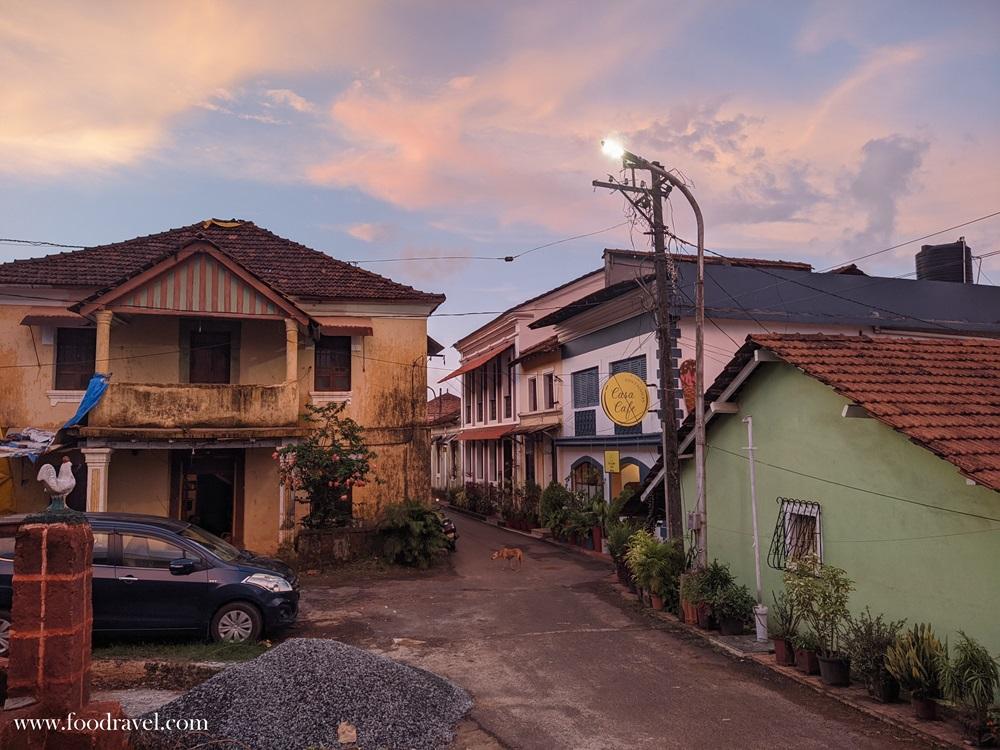Nestled in the heart of Goa, a land renowned for its vibrant culture and rich history, lies a neighborhood unlike any other – Fontainhas, the Latin Quarter of Goa. This picturesque enclave is steeped in history, resplendent in its colorful charm, and cherished for its cultural significance. In this blog, we invite you to embark on a journey through the cobbled streets and pastel-hued houses of Fontainhas, where heritage meets artistry.
The Latin Quarter of Goa boasts a vibrant Portuguese colonial heritage, evident in its architecture, design, and traditions. It wears its history proudly, whispering tales of a time when the Portuguese legacy was etched into its very streets.
One of the first things that will capture your attention in Fontainhas is the profusion of colorful houses. Each building is adorned with hues that are a treat for the eyes. Pastel blues, vibrant yellows, and earthy reds blend together to create an aesthetic that’s uniquely Fontainhas. It’s no wonder that these streets have earned the nickname “a splash of color on the canvas of Goa.”
Throughout this blog, we will delve into the historical roots of the Latin Quarter of Goa, exploring its colonial past. We’ll wander through the charming lanes, where every nook and cranny has a story to tell. You can look forward to discovering the artistic vibes that pulse through this neighborhood, as we take you on a tour of local art galleries, studios, and the works of talented artists. We’ll also embrace the cultural experiences that Fontainhas offers, including insights into the way of life and the traditional festivals celebrated here.
Read Here – Dauna Paula Beach Goa
So, fasten your seatbelts, or should I say, put on your walking shoes, as we embark on a captivating journey through the Latin Quarter of Goa, where heritage meets artistry, and where every corner is a piece of living history.
In the late eighteenth century, a Goan expatriate named António João de Sequeira, affectionately known as “Mossmikar,” played a pivotal role in shaping the unique enclave known as Fontainhas. Having amassed his wealth while working in Mozambique, Mossmikar decided to invest in this picturesque quarter, leaving an indelible mark on Goan history. The very name “Fontainhas” owes its origin to a spring that began to bubble forth around 1770, providing a refreshing and abundant water source.
The name Fontainhas, which translates to ‘little fountain’ in Portuguese, is a fitting tribute to the neighborhood’s origins, stemming from the natural spring nestled at the base of Altinho Hill known as Fonte Phoenix, or the Fountain of Phoenix.
Read Here – Calangute Beach Goa
The inhabitants of the Latin Quarter of Goa have deep-rooted connections to the original Portuguese settlers, with many families tracing their ancestry back to these early inhabitants. Today, most of the houses have been retained as private homes, while some have been thoughtfully converted into charming guesthouses, preserving the neighborhood’s historical essence.

Fontainhas showcases its rich multicultural character, as the majority of its population (approximately 3,500 people as of 2011) adheres to the Roman Catholic faith. Their homes typically feature a wooden cross prominently displayed on their doors. However, in this harmonious community, a significant portion of residents practice Hinduism, symbolizing their faith by tending to the sacred tulsi plant outside their homes.
Amid the labyrinth of streets in the Latin Quarter of Goa, one can discover a myriad of local bakeries and quaint cafes, adding to the neighborhood’s delightful character. The streets themselves are steeped in history and bear names linked to significant dates, such as the 18th June Road, commemorating the 1946 revolt that marked a turning point in the fight against Portuguese colonial rule in Goa. Another noteworthy thoroughfare, the 31st January Road, pays homage to a republican uprising in Portugal in 1891, resonating with the spirit of the neighborhood’s heritage and its global connections.
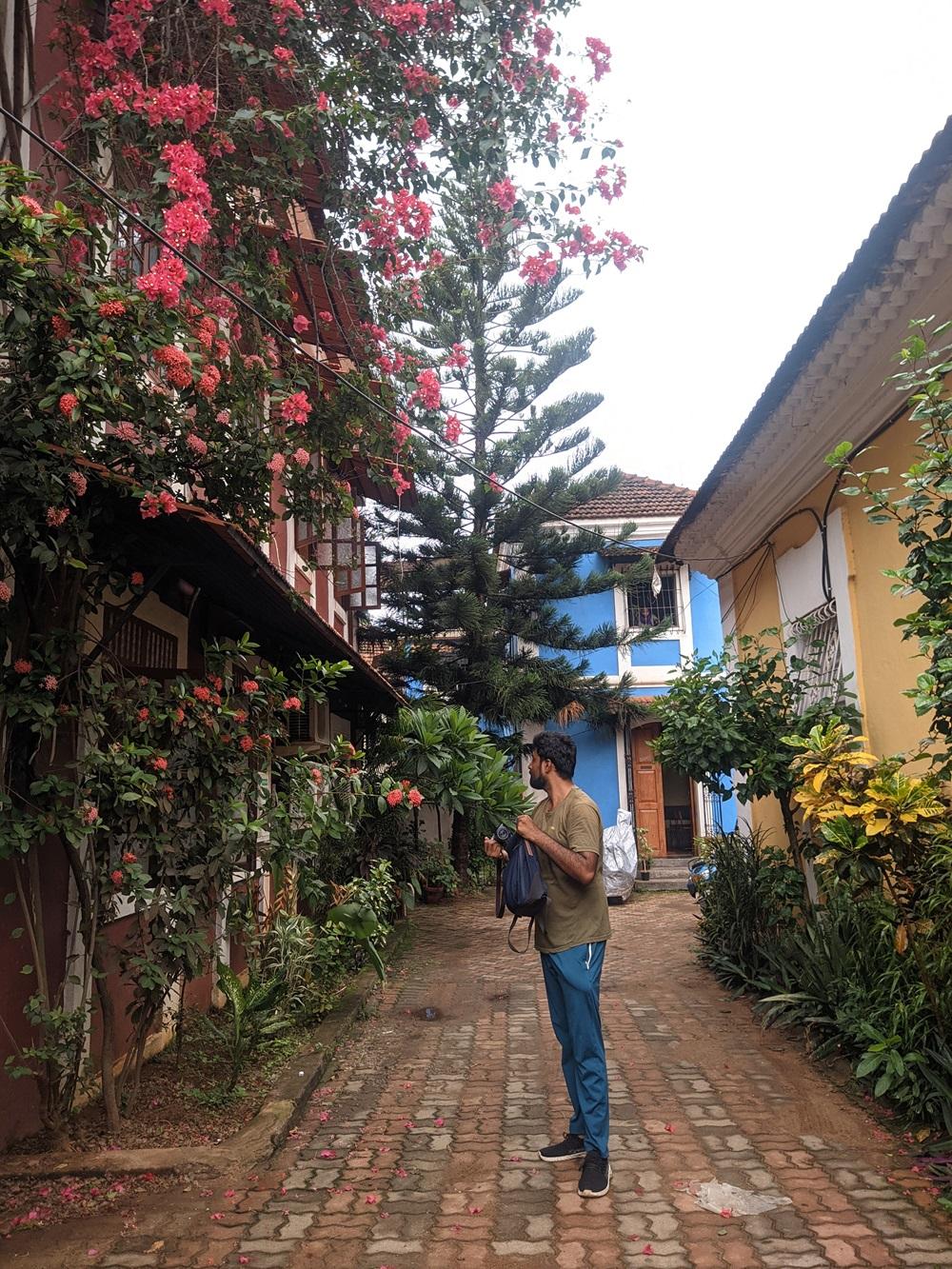
Patterned along the lines of Lisbon’s enchanting Bairro Alto, Fontainhas exudes an unmistakable Portuguese charm that transports visitors back to the colonial era. Its story unfolds as a tale of wealth, vision, and the enduring influence of Portugal on this Indian coastal paradise.
In 1844, an astute government administrator, determined to instill a sense of order and decorum in Goa, embarked on a mission to transform this Latin Quarter of Goa, i.e., Fontainhas. His vision gave rise to the Rua Nova d’Ouremsea, an elegant street with a parapet running along the seaward side of the Fontainhas Bairro (Quarter). Here, even people from the lower strata of society were expected to present themselves properly attired in public. The street was a testament to this pursuit of refinement. Additionally, the Phenis fountain emerged as a centerpiece, featuring an ornate façade and a welcoming porch. These interventions enriched the neighborhood and further underscored its Portuguese influence.
Fontainhas was marked by a high population density. The affluent residents occupied the large bungalows atop Panjim hill, while those less financially endowed resided at the foot and to the east of the hill. Their homes were nestled between the hill itself and a small tidal creek. However, during the low flow season, this creek dried up, leaving behind a foul odor that, in itself, became part of the area’s history.
Travel writer and historian William Dalrymple aptly describes Fontainhas as a “small chunk of Portugal washed up on the shores of the Indian Ocean.” This neighborhood remains a unique haven where the Portuguese language continues to be the primary spoken tongue, a testament to its enduring legacy.
In this Latin Quarter of Goa, history and heritage intertwine, bringing forth a neighborhood that has defied the passage of time. Join us on a captivating journey through its streets, delving deeper into its past, and uncovering the vibrant culture that makes Fontainhas a jewel on Goa’s coastal crown.
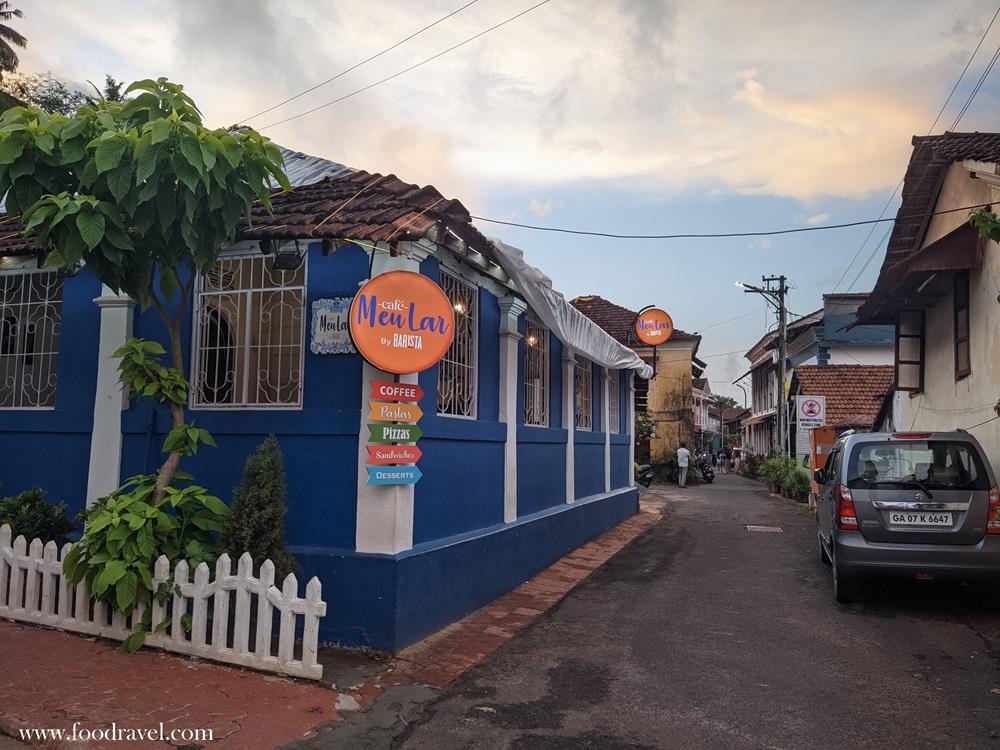
Exploring Fontainhas’ Timeless Architectural Elegance in the Latin Quarter of Goa
One of the most captivating aspects of Fontainhas is the pristine preservation of its colonial-era architecture. The neighborhood is a living canvas of 18th and 19th-century Portuguese architectural elegance. Its old houses, with their red-tiled roofs and pastel-colored facades, remain in their original state, offering a vivid window into the past. The serene elegance of these buildings instantly transports you to a bygone era, a testament to the enduring charm of Portuguese influence in Goa.
The Fundacão Orienté, a Portuguese public organization dedicated to heritage restoration in Goa, plays a pivotal role in maintaining the authenticity of this quarter of Panjim. Its commitment to restoration ensures that the architectural heritage stands the test of time. Notably, Fonte Phoenix, well fed by a natural spring within the neighborhood, has been carefully refurbished, serving as a symbol of continuity and heritage.
The allure of this Latin Quarter of Goa goes beyond its architectural treasures; it also thrives as an artistic hub. Many art galleries can be found within its lanes, providing a platform for local and international artists to showcase their creativity. These galleries often house charming cafes where you can relax and immerse yourself in the artistic ambiance.
As the sun begins to set, Fontainhas unveils another layer of its enchanting personality. Unmarried women gather on the roofed gallery steps, adorned in colorful, flowery dresses, sharing stories and scanning newspapers in Portuguese.
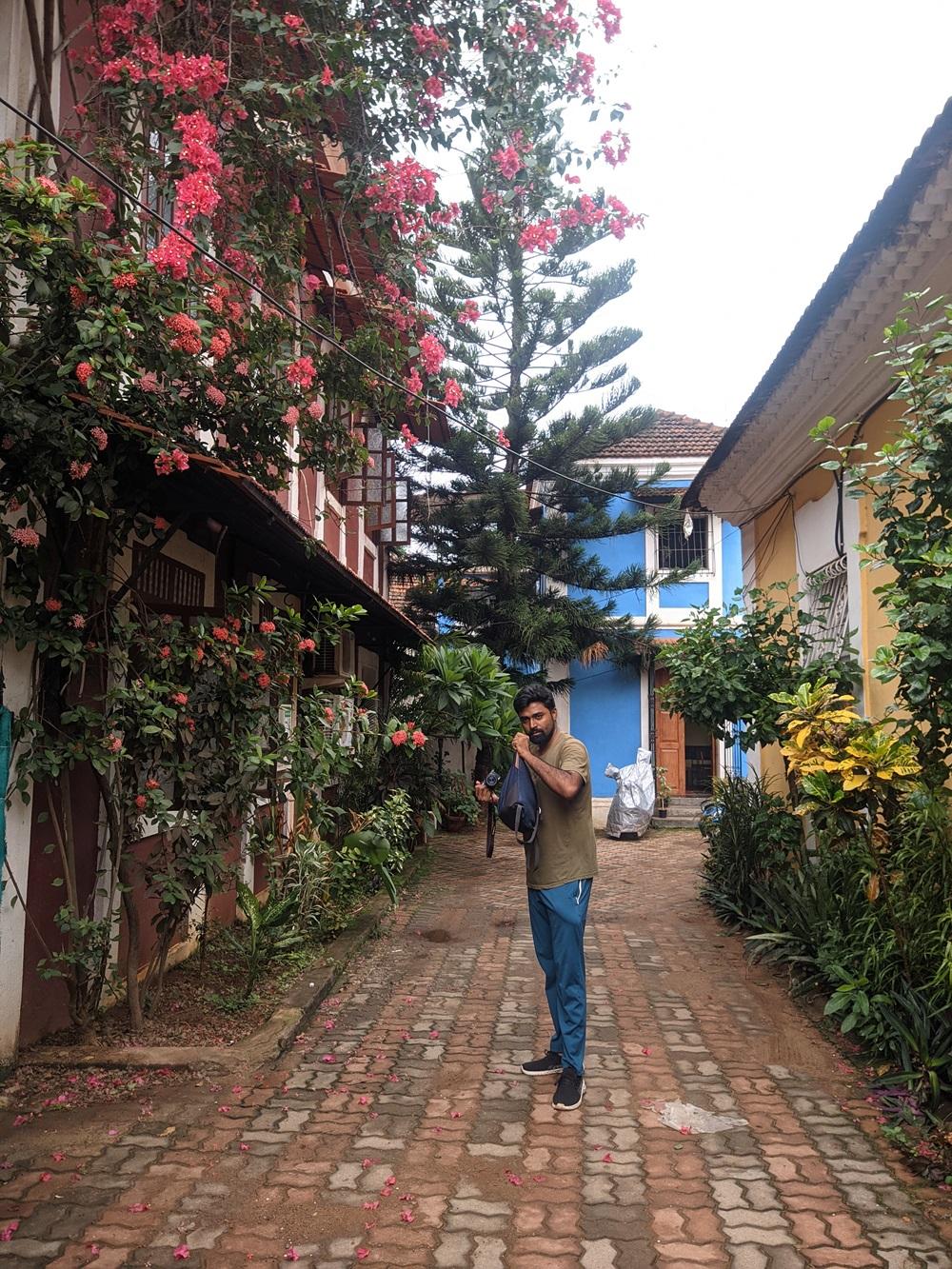
Violinists serenade the neighborhood with the musical works of Heitor Villa-Lobos from their windows, while birdcages dangle from ornate balconies, overlooking the quaint red-tiled city square. The cobbled streets come alive with the sight of well-dressed elderly individuals, their Homburg hats and linen pants adding to the picturesque charm.
Fontainhas’ commitment to cleanliness is another endearing quality. Its houses and lanes are immaculately maintained, keeping the colonial architecture and heritage alive. A tradition rooted in Portuguese rule mandates that every urban resident repaint their house annually after the monsoons, ensuring that the quarter remains as colorful as ever.
While some aristocratic mansions have given way to modern structures, traces of old houses belonging to affluent Indo-Portuguese families can still be found in the neighborhood. The back lanes of this Latin Quarter of Goa reveal hidden facets of these timeless residences, each with its unique stories to tell.
A popular theme walk through Fontainhas focuses on its architectural elegance, offering visitors an immersive experience into the heritage of this atmospheric area. The serene lanes and beautifully maintained houses allow you to step back in time and relish the architectural grandeur of the Latin Quarter of Goa.
Discovering Colorful and Well-Preserved Portuguese Houses at Fontainhas
In the heart of this Latin Quarter of Goa, one is greeted by a visual fiesta of colorful houses that stand as living testaments to the rich Portuguese heritage. Dating back to the 18th and 19th centuries, these charming houses have retained their original splendor. With vibrant red-tiled roofs and walls adorned in soothing shades of pale yellow, green, or blue, each house tells a story of a bygone era. The Fundacão Orienté, a Portuguese public organization dedicated to the restoration of heritage buildings in Goa, has played a pivotal role in maintaining the elegant aesthetics of these architectural gems. It’s a walk down these picturesque streets that transports you to a different time and place, where the elegance of the past remains vibrant and captivating.
Wandering the Narrow Winding Streets
Fontainhas is a place where you get lost in the labyrinth of narrow, winding streets, and it’s precisely what makes this neighborhood so enchanting. These cobbled lanes seem to have preserved the echo of centuries past, beckoning explorers to unravel their mysteries. As you stroll through these charming streets, you’ll encounter scenes reminiscent of a bygone era. Unmarried women in colorful flowery dresses gather on the roofed gallery steps, engaged in leisurely conversations or scanning newspapers. Violinists serenade the neighborhood with the harmonious melodies of Heitor Villa-Lobos from the windows, while the cheerful chirping of caged birds graces the ornate balconies. Fontainhas encapsulates a Mediterranean-like tranquility that unfolds in its lanes, making every step an exploration of the past.
Embracing the Historic Significance
Beyond its visual allure, Fontainhas carries profound historic significance. It is a place where you can feel the pulse of a bygone era, where rich Indo-Portuguese culture once thrived. While many of the aristocrats’ mansions have made way for modern structures, some houses that were once owned by affluent Indo-Portuguese families still stand as poignant reminders of the neighborhood’s storied past. Windows and balconies of these houses offer glimpses into the back lanes of Fontainhas, serving as windows to another time. The tradition of painting houses annually after the monsoons, a practice mandated by Portuguese rule, is still upheld with pride here. Every nook and corner tells a story, and Fontainhas is a living museum of history and culture, inviting travelers to delve into its captivating narrative.
Unveiling the Artistic Soul of Fontainhas
Beyond its architectural grandeur and historic resonance, Fontainhas is a nurturing hub for artistic expression. This Latin Quarter of Goa has earned a reputation as an enclave where art is not just celebrated but thrives. The artistic soul of this neighborhood transcends time, embracing the contemporary spirit while staying rooted in its cultural heritage. As you traverse the charming streets, you’ll notice that this Latin Quarter of Goa is not merely a visual treat; it’s a canvas in constant evolution, filled with creativity and artistic vibes.
A Haven for Art Galleries, Studios, and Local Artists
Art enthusiasts will find themselves delighted in Fontainhas, where art is woven into the very fabric of the community. Numerous art galleries grace the neighborhood, providing a platform for local and international artists to showcase their works. Among them, the famous Gitanjali Gallery stands out as a testament to the thriving art scene in Fontainhas. These galleries are not just spaces to display art but also vibrant centers where creativity is nurtured. Inside the walls of these studios, you’ll encounter a diverse range of artistic expressions, from paintings and sculptures to multimedia installations. As you delve into these artistic spaces, you’ll get a glimpse of the talent that thrives in Fontainhas, creating a harmonious blend of tradition and contemporary artistry.
Celebrating Art Festivals and Events at Latin Quarter of Goa - Fontainhas
The artistic fervor of this Latin Quarter of Goa doesn’t confine itself to galleries and studios; it spills out into the streets during art festivals and events. Throughout the year, this neighborhood comes alive with the sounds of artistic celebrations. Fontainhas hosts a festival in February called the Fontainhas Festival, where residents celebrate their Goan heritage through art and culture by transforming their homes into makeshift art galleries and holding events with music and dancing. Additionally, the neighborhood is a vibrant participant in the feast of St. Sebastian, the Goa Carnival, and the Fontainhas Cultural Festival. From vibrant street art festivals that add splashes of color to the cobbled lanes to cultural gatherings that fuse local traditions with modern expressions, Fontainhas is a dynamic stage for creative minds. While wandering through its streets, you might stumble upon impromptu exhibitions, live performances, or workshops that invite you to immerse yourself in the artistic vibrancy of this Latin Quarter. The fusion of art and culture in Fontainhas transcends boundaries, creating an ever-evolving artistic landscape that captivates all who visit.
Celebrating Art Festivals and Events at Latin Quarter of Goa - Fontainhas
Savoring Local Cuisine
Fontainhas isn’t just a feast for the eyes; it’s also a treat for the taste buds.
Traditional Goan Dishes and Dining
No visit to Fontainhas is complete without indulging in traditional Goan dishes. The neighborhood is home to several restaurants that serve authentic Goan cuisine, from mouthwatering seafood curries to spicy vindaloos and tangy xacuti. You’ll also find Portuguese influences in the cuisine, with dishes like feijoada and Portuguese-style chorizo. The dining experience in Fontainhas isn’t just about the food; it’s about immersing yourself in the cultural fusion that has shaped Goan gastronomy over the centuries.
Unique Dining Experiences
Fontainhas is dotted with charming eateries that offer unique dining experiences. A visit to Fontainhas is not complete without a stop at Confeitaria 31 De Janeiro, an over 80-year-old hole-in-the-wall bakery. Renowned for its Swiss rolls, plum cakes, and patties, it’s a place where you can enjoy a cup of tea with a slice of their oven-fresh tea cakes or Goan snacks. The aroma of freshly baked goods will envelop your senses, making it a perfect prelude or interlude to your exploration of the Latin Quarters.
Just a short stroll away, you’ll find Gourmestan, offering vegan and gluten-free options. Their mango cheesecake is a standout, especially when paired with a cup of coffee. If you need a respite from the sun, this air-conditioned cafe is perfect for a quick recharge before you head out to continue your exploration.
For those in search of modern delights, the Tea Trunk Experience Center awaits. Curated by India’s first tea sommelier, it offers a delightful selection of teas, from Floral Galaxy Lemonade to hibiscus iced tea. If you prefer hot tea, don’t miss the saffron kahwa, lavender white tea, and masala chai hot chocolate. Their menu also includes tempting snacks like the roasted chicken croissant sandwich and delectable sweets such as the lemon lavender tea cake, chamomile cupcake, and earl gray shortbread cookie.
While wandering the narrow streets of the Latin Quarter of Goa, you’ll come across local taverns. For a taste of local spirits, these are the perfect pit stops. Joseph’s and Miski bars are popular watering holes, offering a glimpse into the local drinking culture.
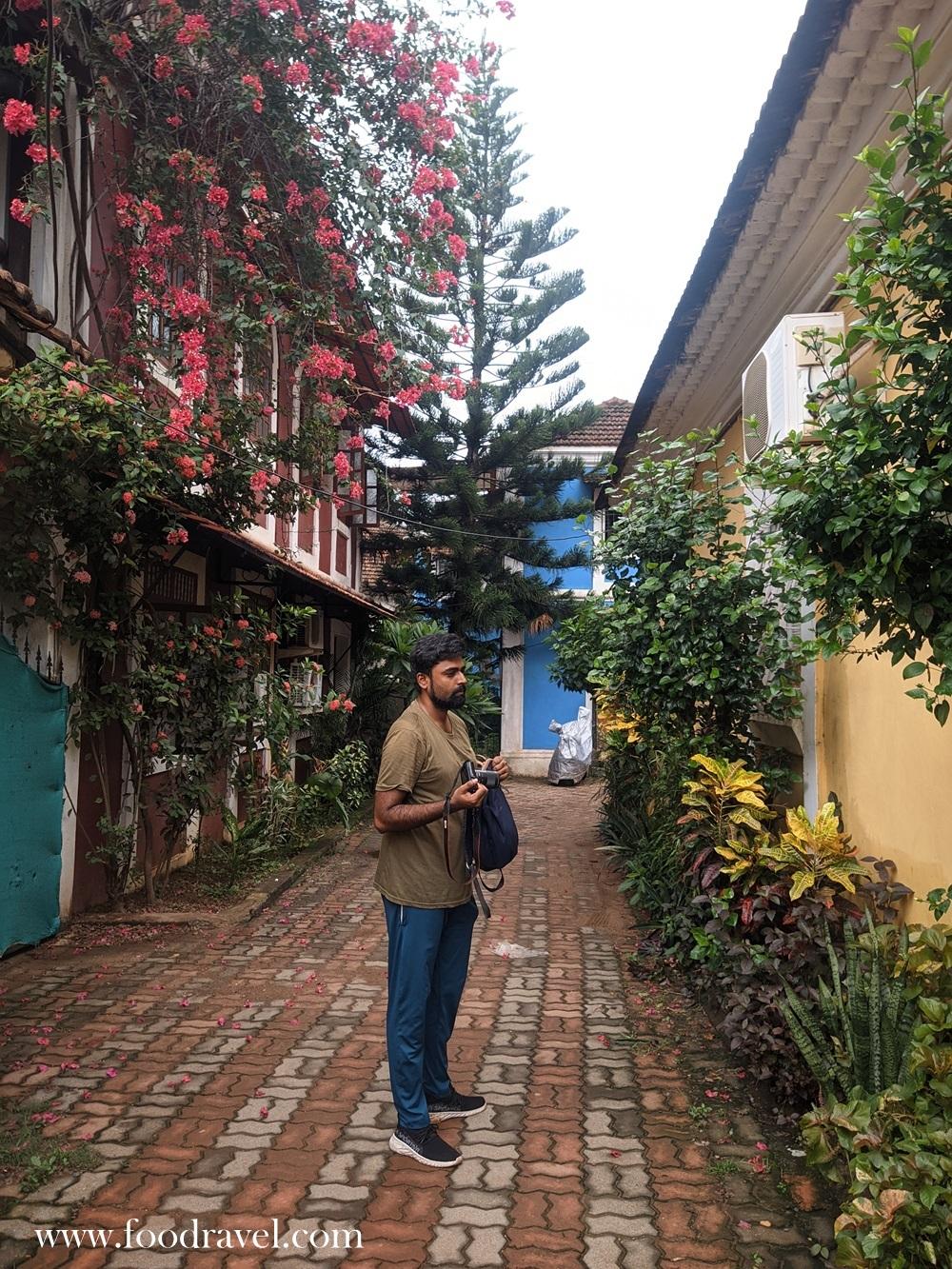
If you prefer a more upscale experience, you can explore establishments like DTR (Down The Road), Soho, The Outpost, and more, ensuring that every palate finds its ideal delight.
From traditional to contemporary, the Latin Quarter of Goa is a culinary paradise that celebrates the diversity of flavors and cultural influences, making each dining experience an integral part of your Fontainhas journey.
Preserving the Timeless Charm of Latin Quarter of Goa
Guardians of Heritage
Fontainhas’ rich cultural and architectural heritage is a testament to the passionate efforts of both residents and heritage conservation organizations. Their commitment to preserving this unique neighborhood has helped maintain its authenticity over the years.
Many residents have taken it upon themselves to restore and maintain their ancestral homes, ensuring that the vibrant colors and intricate designs of the Portuguese-era buildings continue to charm visitors.
Organizations Leading the Way
The Fundacão Orienté, a Portuguese public organization, has played a significant role in the restoration of heritage buildings in Fontainhas. Their dedicated work has ensured that these architectural marvels stand the test of time.
Local heritage preservation initiatives have also been championed by the Goa Heritage Action Group, which aims to protect and promote the state’s cultural heritage, including the Latin Quarter of Fontainhas.
The Significance of Preservation
Preserving Fontainhas is not merely an act of conserving buildings; it’s safeguarding a living, breathing piece of history. The neighborhood stands as a bridge between the past and the present, offering invaluable insights into Goa’s colonial legacy.
My journey to the Latin Quarter of Goa unfolded in two distinct chapters. The first was an impromptu visit during my return from the vibrant shores of Baga Beach. It was a brief stop, a mere taste of what Fontainhas had to offer. The second visit, however, was a more deliberate exploration, a day dedicated to unearthing the treasures of this historic neighborhood.
On my way back from the lively Baga Beach, I found myself drawn to the tranquil streets of Fontainhas. The transition was remarkable, as the bustling beachscape gradually gave way to the serene surroundings of the Latin Quarter. The most striking features were the colorful Portuguese houses, a stark contrast to the beach’s vivacious atmosphere. It was an introduction that left me curious, and I couldn’t resist the allure of a quaint café.
My impromptu visit led me to Café Meu Lar by Barista, a serene pause in my journey. The café embodied the essence of Fontainhas, tranquil, inviting, and rich in history. Here, I savored a cup of aromatic coffee that provided a soothing respite during my travels.
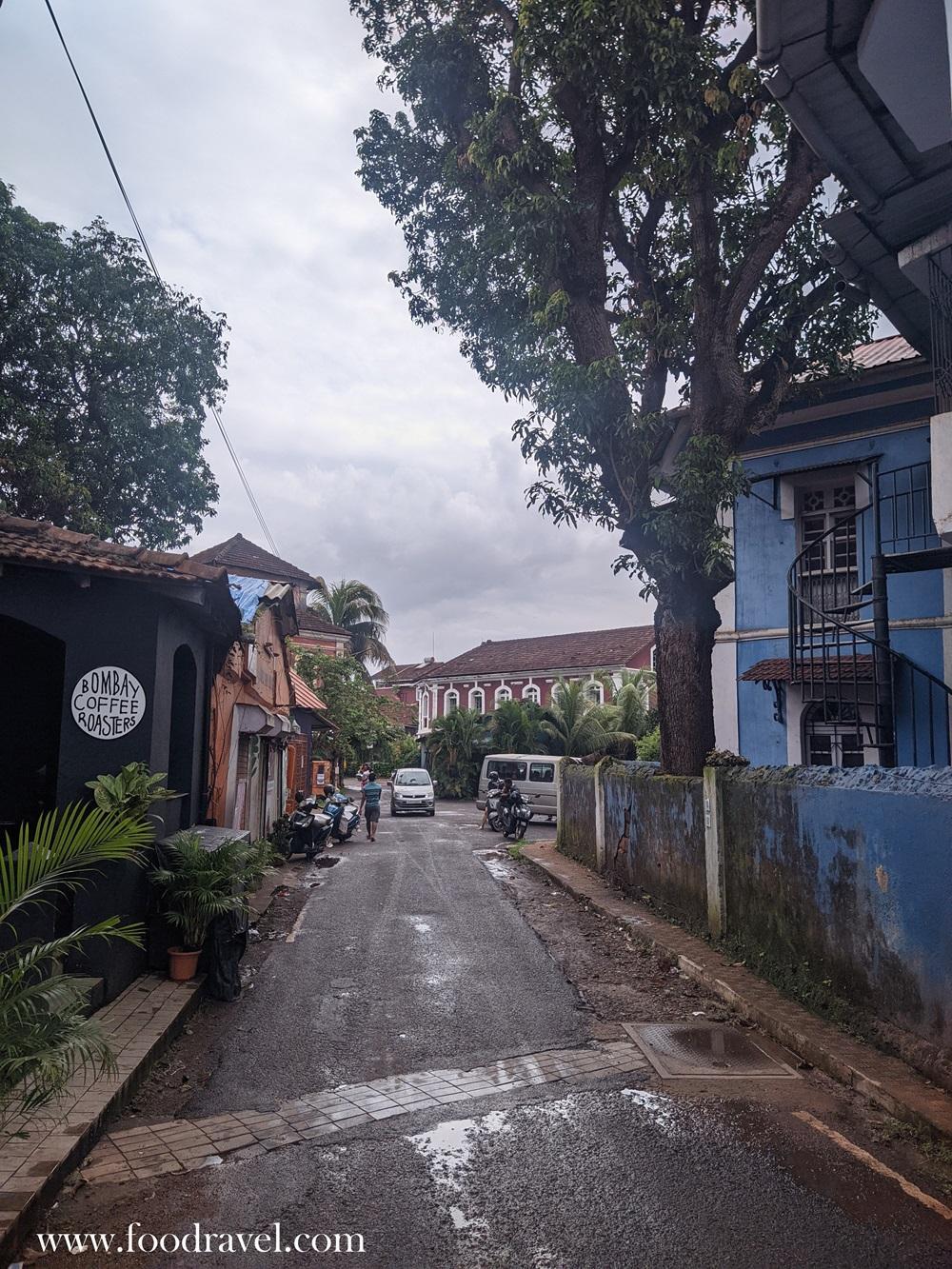
The ambiance was as captivating as the neighborhood itself, with vibrant bougainvillea cascading from balconies and centuries-old architecture that whispered tales of the past.
My second visit to the Latin Quarter was a day of exploration, a deliberate decision to immerse myself in its wonders. The morning sun beckoned me, and I answered its call with a visit to Bombay Coffee Roasters. The aroma of freshly brewed coffee and the promise of a hearty breakfast set the stage for another enchanting experience.
Bombay Coffee Roasters proved to be a hidden gem, a culinary delight that perfectly complemented the ambiance of Fontainhas. I enjoyed a steaming cup of coffee, its flavors infused with the passion of a dedicated roaster. To accompany my coffee, I indulged in a delectable sandwich. As I sipped and savored, I watched the world go by, immersing myself in the unhurried pace of Fontainhas.
These encounters, whether brief or extended, etched indelible memories in my mind. They were the windows through which I peered into the soul of the Latin Quarter, a place where time stands still, and history and culture merge seamlessly. Each visit was a chapter in the story of Fontainhas, a narrative that continues to unfold with each passerby and visitor who discovers the magic of this charming neighborhood.
![]()

